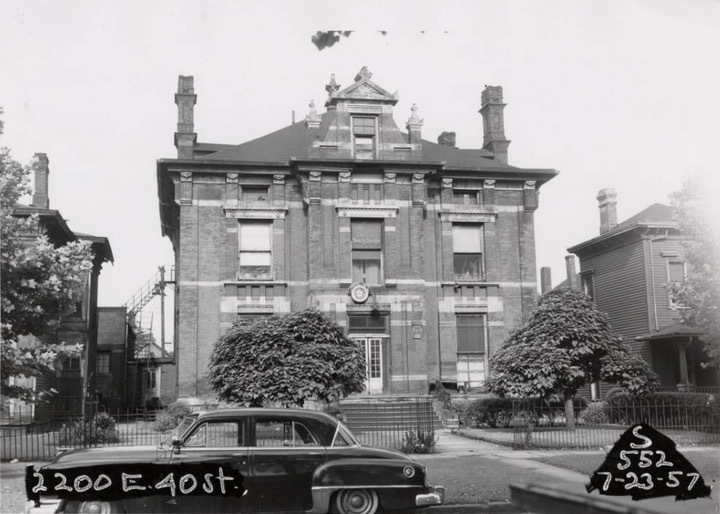Liberty Hall
The Universal Negro Improvement Association in Cleveland

“Cleveland Garveyites regularly paraded through the city’s black belt, proudly wearing their all-black military styled uniforms and carrying the UNIA’s red, black, and green flag. The flag signified black pride and African Liberation.” – Erick McDuffie
After the Great Migration a new nationalist movement arose in African American communities across the U.S., with Marcus Garvey as its spearhead. Founded by Garvey in 1914, the Universal Negro Improvement Movement (UNIA) stressed black pride, community solidarity, connecting the racial struggles in the U.S. to those of black people across the world. Garvey protested white colonization and called for “all men and women within the reach of the blood of Afric[a]" to be proud of their race.” The UNIA by-laws provided a script for each member oath to the organization that included a pledge to “the redemption of my motherland Africa.” This pride in African heritage in the UNIA is evident even in their anthem, “Ethiopia, Thou Land of our Fathers.” Garveyism and the UNIA gained influence in the Midwest, and more specifically in Cleveland, which would house the UNIA headquarters throughout the 1940s and again in the 1970s and 1980s.
During Marcus Garvey’s visit to Cleveland in May 1920, he spoke to more than 400 people at Cory United Methodist Episcopal Church. The audience's exuberant response demonstrates how Garvey’s Pan-African message truly captured the lives of those present. Inspired by Garvey’s message, the UNIA in Cleveland became a major force in local politics, as illustrated in continuous coverage of its Cleveland activates in Garvey’s newspaper Negro World. These efforts helped expand the Cleveland UNIA (Division 59) to more than 5,000 members by 1922, and by 1923 it claimed 15,000. This was the same year that the Cleveland UNIA, through the small donations of organization members, was able to purchase a stately three-story mansion located at 2200 East 40th Street. Liberty Hall, as it was later named, was located in the heart of the Central neighborhood. This building served not only as the headquarters space for the UNIA but also as a bustling African American community center, committed to uplifting black peoples in Cleveland and globally.
Initially, following Garvey’s mail fraud conviction and deportation, he reorganized the international UNIA at the 1929 convention, forming the Universal Negro Improvement Association and African Communities League, August 1929 of the World (UNIA-ACL). Although some charters fought Garvey on his changes, the Cleveland UNIA remained loyal and received its new charter as Division 133 from the UNIA Parent Body in 1930. It was during this time that the chapter started to face factionalism and decline. Issues with intra-racial strife, sexism, and class issues, among others, caused initial decline for the organization. Debates also focused around the issues of dancing, drinking, smoking, and women’s behavior. The black middle class, which comprised most of the Cleveland chapter, traditionally associated these activities with the recklessness of the black urban working-class. During the Depression many African Americans on Cleveland’s East Side started to migrate toward other black power groups, including the Future Outlook League (FOL) and the National Association for the Advancement of Colored People (NAACP) as a result of this strife within the organization.
The UNIA-ACL Cleveland branch, however, committed itself to the ideals of Pan-Africanism throughout the 1940s. In August 1940, James R. Stewart, who was serving as a UNIA-ACL commissioner for the state of Ohio and as president of the Cleveland branch, was elected acting president general at the time of Garvey’s death. By October, Stewart had established Cleveland as the new location for the UNIA-ACL Parent Body headquarters. The Parent Body remained in Cleveland until 1949. Part of what led to the chapter's downfall during this time was Stewart's push for voluntary African American repatriation to Liberia. Similar to Garvey, Stewart believed that the repatriation would assist in civilizing Africa and solving the American race issue. In the case of Cleveland, most African Americans were more concerned about obtaining full citizenship and rights in the U.S., rather than emigrating to Africa. These ideas, in conjunction with other black rights organizations like the FOL and NAACP supporting black rights at home, led to a continuing decline in membership. Stewart decided to take Liberian citizenship for himself in 1949, moving the Parent Body to Monrovia, Liberia. After Stewart’s death in 1964, the Parent Body moved to Chicago where it remained until 1975.
When the Civil Rights and Black Power movements arrived to Cleveland in the 1960s, the Cleveland UNIA-ACL was playing a marginal role at best. Garveyism during this time, however, took on a new life though new local Black Power organizations comprised of young black nationalists who consciously saw themselves as Garveyites. Inspired by Garvey’s defiant call for black self-determination, young black Clevelanders formed other Black Nationalist groups such as the House of Israel and the Afro-Set. Most of this new generation of Garveyites was unaware of the UNIA-ACL, but rather had come to Garveyism through the Nation of Islam or other veteran black nationalists. Kwame Nkrumah, the leader during Ghana’s independence, is said to have been greatly inspired by Garvey. In the U.S., Malcolm X is also said to have been influenced by Garvey in his desire to make a unified black pride on an international scale. In Cleveland’s more recent past, and even today, as the struggle for black rights rages on, people remember the influences of Garvey, and the UNIA-ACL, and the role they played in shaping the black power movements still present today.
Images





UNIA-ACL Cleveland, OH.

Date: 1940


